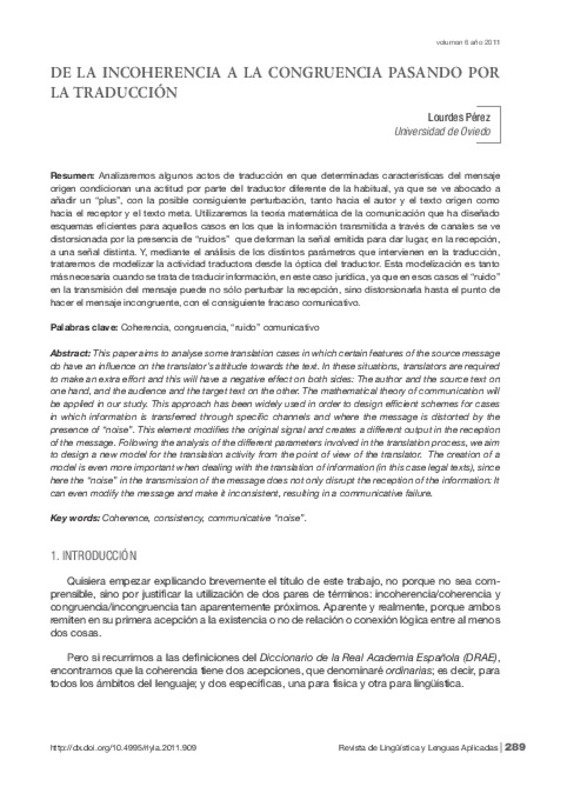JavaScript is disabled for your browser. Some features of this site may not work without it.
Buscar en RiuNet
Listar
Mi cuenta
Estadísticas
Ayuda RiuNet
Admin. UPV
DE LA INCOHERENCIA A LA CONGRUENCIA PASANDO POR LA TRADUCCIÓN
Mostrar el registro sencillo del ítem
Ficheros en el ítem
| dc.contributor.author | Pérez, Lourdes
|
es_ES |
| dc.date.accessioned | 2011-10-26T12:58:14Z | |
| dc.date.available | 2011-10-26T12:58:14Z | |
| dc.date.issued | 2011 | |
| dc.identifier.issn | 1886-2438 | |
| dc.identifier.uri | http://hdl.handle.net/10251/12399 | |
| dc.description.abstract | [EN] This paper aims to analyse some translation cases in which certain features of the source message do have an influence on the translator’s attitude towards the text. In these situations, translators are required to make an extra effort and this will have a negative effect on both sides: The author and the source text on one hand, and the audience and the target text on the other. The mathematical theory of communication will be applied in our study. This approach has been widely used in order to design efficient schemes for cases in which information is transferred through specific channels and where the message is distorted by the presence of “noise”. This element modifies the original signal and creates a different output in the reception of the message. Following the analysis of the different parameters involved in the translation process, we aim to design a new model for the translation activity from the point of view of the translator. The creation of a model is even more important when dealing with the translation of information (in this case legal texts), since here the “noise” in the transmission of the message does not only disrupt the reception of the information: It can even modify the message and make it inconsistent, resulting in a communicative failure. | es_ES |
| dc.description.abstract | [ES] Analizaremos algunos actos de traducción en que determinadas características del mensaje origen condicionan una actitud por parte del traductor diferente de la habitual, ya que se ve abocado a añadir un "plus", con la posible consiguiente perturbación, tanto hacia el autor y el texto origen como hacia el receptor y el texto meta. Utilizaremos la teoría matemática de la comunicación que ha diseñado esquemas eficientes para aquellos casos en los que la información transmitida a través de canales se ve distorsionada por la presencia de "ruidos" que deforman la señal emitida para dar lugar, en la recepción, a una señal distinta. Y, mediante el análisis de los distintos parámetros que intervienen en la traducción, trataremos de modelizar la actividad traductora desde la óptica del traductor. Esta modelización es tanto más necesaria cuando se trata de traducir información, en este caso jurídica, ya que en esos casos el "ruido" en la transmisión del mensaje puede no sólo perturbar la recepción, sino distorsionarla hasta el punto de hacer el mensaje incongruente, con el consiguiente fracaso comunicativo. | |
| dc.language | Español | es_ES |
| dc.publisher | Editorial Universitat Politècnica de València | es_ES |
| dc.relation.ispartof | Revista de Lingüística y Lenguas Aplicadas | |
| dc.rights | Reserva de todos los derechos | es_ES |
| dc.subject | Coherencia | es_ES |
| dc.subject | Congruencia | es_ES |
| dc.subject | Ruido comunicativo | es_ES |
| dc.subject | Coherence | es_ES |
| dc.subject | Consistency | es_ES |
| dc.subject | Communicative noise | es_ES |
| dc.title | DE LA INCOHERENCIA A LA CONGRUENCIA PASANDO POR LA TRADUCCIÓN | es_ES |
| dc.type | Artículo | es_ES |
| dc.date.updated | 2011-10-26T11:18:49Z | |
| dc.identifier.doi | 10.4995/rlyla.2011.909 | |
| dc.rights.accessRights | Abierto | es_ES |
| dc.description.bibliographicCitation | Pérez, L. (2011). DE LA INCOHERENCIA A LA CONGRUENCIA PASANDO POR LA TRADUCCIÓN. Revista de Lingüística y Lenguas Aplicadas. 6:289-298. https://doi.org/10.4995/rlyla.2011.909 | es_ES |
| dc.description.accrualMethod | SWORD | es_ES |
| dc.relation.publisherversion | https://doi.org/10.4995/rlyla.2011.909 | |
| dc.description.upvformatpinicio | 289 | |
| dc.description.upvformatpfin | 298 | |
| dc.description.volume | 6 | |
| dc.identifier.eissn | 1886-6298 | es_ES |








